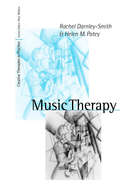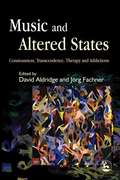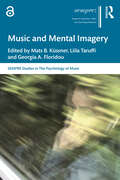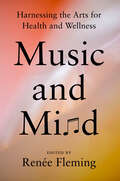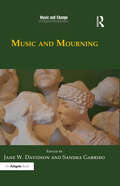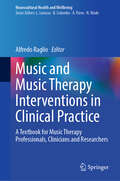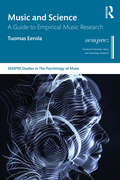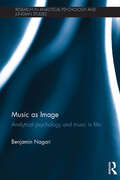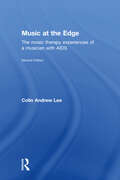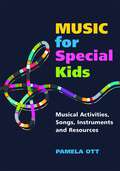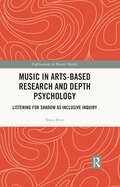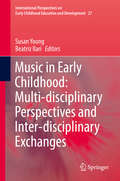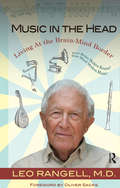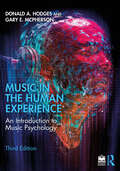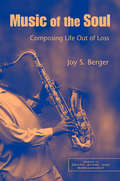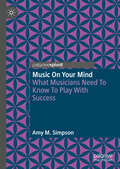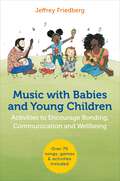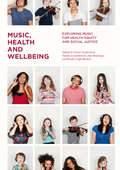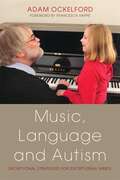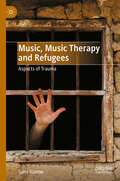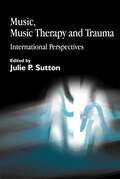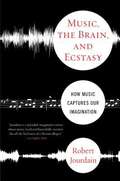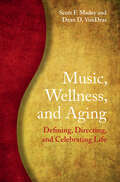- Table View
- List View
Music Therapy: Psychodynamic Music Therapy In Europe: Clinical, Theoretical And Research Approaches (Creative Therapies in Practice series)
by Helen M Patey Ms Rachel Darnley-Smith`This book is a detailed introduction to music therapy, and should be of particular interest to intending students of the subject and those wishing to pursue a career within the profession. It should be of considerable use to all with a general interest in the subject as well those making a career on music therapy' - The Organ `I found this a useful book in terms of its clarity and carefully thought out structure. It is a rich source of information and of ideas which are extremely important for the potential music therapy trainee to think about; it also makes valuable reading for more experienced therapists, bringing our minds back to some central questions about the nature of our work.... Whatever stage you may be at in your life as a music therapist, it will refresh your mind and your practice' - Eleanor Richards, Nordic Journal of Music Therapy From the Foreword: `Rachel Darnley-Smith and Helen M Patey have managed so well to tell their story of music therapy offering the framework of theory, training and professional practice, and the complimentary value of Analytical Music Therapy and Creative Music Therapy within improvization. The authors devote a whole chapter to promoting a wider understanding of improvisation, describing its value as a form of play, free association, with more or less structure depending on the form of intervention and the client's needs. There is really a valuable resource of meaningful and relevant examples from their own clinical work. These examples clearly validate and illustrate the seminal theoretical concept of the first great pioneer of music therapy in the United Kingdom, Juliette Alvin, who taught us that music is a creation of people, and therefore we can see people in their music' - Professor Tony Wigram Music Therapy is an introduction to contemporary training and practice. Written in a clear, jargon-free style, the book provides a lively source of information and ideas for all who are new to music therapy. Written by highly experienced practitioners, the book examines improvization, the principal method for music therapy, and points to the underlying assumptions about music, which shape this way of working. Two of the main music therapy approaches - Analytic Music Therapy and Nordoff- Robbins Music Therapy - are also outlined. Drawing on their own experience, the authors examine a range of clinical situations and give examples of working with children and adults with a range of needs, including autism, learning disabilities and mental health problems. They highlight the many issues which arise from day-to-day practice and explore other aspects of professional life, such as personal therapy and supervision. For anyone training or thinking of training to be a music therapist, this book provides an ideal place to start. As a guide to contemporary music therapy, it also has much to offer those already in practice.
Music and Altered States: Consciousness, Transcendence, Therapy and Addictions
by David Aldridge Lucanne Magill Joerg Fachner Dalia Cohen Tsvia HoreshThis international collection examines the opportunities for using music-induced states of altered consciousness to promote physical and mental healing, treat substance dependence, and in spiritual and palliative care. The contributors describe the successful use of altered states and their therapeutic potential, providing examples from different cultures and clinical, therapeutic and spiritual settings. Their observations cover a wide range of music types capable of inducing altered states, including polyrhythmic music, monotonous drumming, Western pop, and Arab musical schemata, complemented by theoretical and clinical approaches to applications in music therapy. This book will be a useful reference for practising music therapists, musicologists, and ethnomusicologists, students and academics in the field.
Music and Mental Imagery (SEMPRE Studies in The Psychology of Music)
by Mats B. Küssner Liila Taruffi Georgia A. FloridouDrawing on perspectives from music psychology, cognitive neuroscience, philosophy, musicology, clinical psychology, and music education, Music and Mental Imagery provides a critical overview of cutting-edge research on the various types of mental imagery associated with music. The four main parts cover an introduction to the different types of mental imagery associated with music such as auditory/musical, visual, kinaesthetic, and multimodal mental imagery; a critical assessment of established and novel ways to measure mental imagery in various musical contexts; coverage of different states of consciousness, all of which are relevant for, and often associated with, mental imagery in music, and a critical overview of applications of mental imagery in health, educational ,and performance settings. By both critically reviewing up-to-date scientific research and offering new empirical results, this book provides a unique overview of the different types and origins of mental imagery in musical contexts, various ways to measure them, and intriguing insights into related mental phenomena such as mind-wandering and synaesthesia. This will be of particular interest for scholars and researchers of music psychology and music education. It will also be useful for practitioners working with music in applied health and educational contexts.
Music and Mind: Harnessing the Arts for Health and Wellness
by Edited by Renée Fleming"This book inspires us all to immerse ourselves in the vast potential of music and other creative arts to heal our wounds, sharpen our minds, enliven our bodies, and restore our broken connections.&” —Bessel van der Kolk, #1 New York Times bestselling author of The Body Keeps the ScoreWorld-renowned soprano and arts/health advocate Renée Fleming curates a collection of essays from leading scientists, artists, creative arts therapists, educators, and healthcare providers about the powerful impacts of music and the arts on health and the human experienceChapters include: Ann Patchett, &“How to Fall in Love with Opera&” Yo-Yo Ma, &“Nature, Culture, and Healing&”Aniruddh D. Patel, &“Musicality, Evolution, and Animal Responses to Music&”Richard Powers, &“The Parting Glass"Daniel J. Levitin, &“What Does It Mean to be Musical?&” Anna Deavere Smith, &“Healing Arts&” Rosanne Cash, &“Rabbit Hole&” Rhiannon Giddens, &“How Music Shows Us What It Means to Be Human&”Robert Zatorre, &“Musical Enjoyment and the Reward Circuits of the Brain&”Concetta Tomaino, &“Music and Memory&”A compelling and growing body of research has shown music and arts therapies to be effective tools for addressing a widening array of conditions, from providing pain relief andalleviating anxiety and depression to regaining speech after stroke or traumatic brain injury, and improving mobility for people with disorders that include Parkinson&’s disease and MS.In Music and Mind Renée Fleming draws upon her own experience as an advocate to showcase the breadth of this booming field, inviting leading experts to share their discoveries. In addition to describing therapeutic benefits, the book explores evolution, brain function, childhood development, and technology as applied to arts and health.Much of this area of study is relatively new, made possible by recent advances in brain imaging, and supported by theNational Institutes of Health, major hospitals, and universities. This work is sparking an explosion of public interest in the arts and health sector.Fleming has presented on this material in over fifty cities across North America, Europe, and Asia, collaborating with leading researchers, policy-makers, and practitioners. With essays from notable musicians, writers, and artists, as well as leading neuroscientists, Music and Mind is a groundbreaking book, the perfect introduction and overview of this exciting new field.
Music and Mourning (Music and Change: Ecological Perspectives)
by Sandra Garrido Jane W. DavidsonWhile grief is suffered in all cultures, it is expressed differently all over the world in accordance with local customs and beliefs. Music has been associated with the healing of grief for many centuries, with Homer prescribing music as an antidote to sorrow as early as the 7th Century BC. The changing role of music in expressions of grief and mourning throughout history and in different cultures reflects the changing attitudes of society towards life and death itself. This volume investigates the role of music in mourning rituals across time and culture, discussing the subject from the multiple perspectives of music history, music psychology, ethnomusicology and music therapy.
Music and Music Therapy Interventions in Clinical Practice: A Textbook for Music Therapy Professionals, Clinicians and Researchers (Neurocultural Health and Wellbeing)
by Alfredo RaglioThis textbook aims to provide practical and comprehensive guidance on the application of music and music therapy in clinical settings. The chapters are written with an evidence-based approach. The first part of the volume defines the psychological, biological, and neuroscientific basis of the therapeutic use of music. Then, various chapters describe the main application techniques (both active and receptive) exploring their therapeutic rationale, purposes, applications in preventive and therapeutic-rehabilitation settings, and possible methods of assessment. An overview of the main clinical areas addressed by music-based therapeutic interventions is also presented, including references to scientific literature, systematic and meta-analytic reviews as well as studies with rigorous methodologies (Randomized Controlled Trials). The final chapter focuses on research, outlining the current state of the art and possible future scenarios within this specific context. The authors of this book are scholars and practitioners in music therapy and related disciplines with recognized experience in clinical and research settings. This book will be an invaluable tool for individuals with an interest in music therapy and its application in clinical settings, such as students studying music therapy, practicing music therapists, researchers, and professionals in related disciplines.
Music and Science: A Guide to Empirical Music Research (SEMPRE Studies in The Psychology of Music)
by Tuomas EerolaMusic and Science provides an introduction and practical guidance for a scientific and systematic approach to music research. Students with a background in humanities may find the field hard to tackle and this accessible guide will show them how to consider using an appropriate range of methods, introducing them to current standards of research practices including research ethics, open access, and using computational tools such as R for analysis. These research methods are used to identify the underlying patterns behind the data to better understand how music is constructed and how we are influenced by music. The book focusses on music perception and the experience of music as approached through empirical experiments and by analysing music using computational tools spanning audio and score materials. The process of research, collaboration, and publishing in this area of study is also explained and emphasis is given to transparent and replicable research principles. The book will be essential reading for students undertaking empirical projects, particularly in the area of music psychology but also in digital humanities and media studies.
Music and the Experience of Memory Loss: Understanding Dementia as a Form of Neurodiversity (Routledge Advances in the Medical Humanities)
by Samantha HarroldThis book is a creative and critical exploration of the memory loss experience. Drawing on in-depth case studies based on primary research, interviews, approaches from music therapy, and theory from Derrida, Malabou, and Royle, it explores how we might better support people living with memory loss.Telling the story of an interpretative phenomenological analysis investigation, this innovative book focuses on conversations with ten people living with memory loss in a nursing home, alongside interviews with the pioneering dementia campaigner Wendy Mitchell. The author argues that, for residents who are living with memory loss, both the nursing home environment and the memory loss experience are uncanny. She considers how archival impulses may manifest themselves at the end of life, before exploring theories of both artistic plasticity and neuroplasticity, proposing that the memory loss state might be thought of as a kind of neurodiversity. The book concludes with suggestions for future methods that alleviate disorientation for people living with memory loss and help with acceptance, the reduction of stress, and better outcomes across multiple disciplines and practices, including music therapy, community musicianship, and the nursing home environment itself.A better understanding of how it feels to live with memory loss is necessary for the development and improvement of practices that are designed to help the memory loss community. This book is an invaluable contribution to research around memory loss, for scholars and practitioners interested in medical humanities, dementia, social care nursing, occupational therapy, and music therapy, among others.
Music as Image: Analytical psychology and music in film (Research in Analytical Psychology and Jungian Studies)
by Benjamin NagariThrough a theoretical and practical exploration of Jungian and post-Jungian concepts surrounding image, this book moves beyond the visual scope of imagery to consider the presence and expression of music and sound, as well as how the psyche encounters expanded images – archetypal, personal or cultural – on both conscious and unconscious levels. By closely examining music in film, Nagari considers music’s complementary, enhancing, meaningful, and sometimes disruptive, contribution to expressive images. Chapters present a Jungian approach to music in film, highlighting how ‘music-image’ functions both independently and in conjunction with the visual image, and suggesting further directions in areas of research including music therapy and autism. Divided into three cumulative parts, Part I explores the Jungian psychological account of the music-image; Part II combines theory with practice in analysing how the auditory image works with the visual to create the ‘film as a whole’ experience; and Part III implements a specific understanding of three individual film cases of different genres, eras and styles as psychologically scrutinised ‘case histories’. Music as Image will be of interest to academics and students in the fields of applied psychoanalysis and Jungian psychology, music, film and cultural studies. With implications for music therapy and other art-based therapies, it will also be relevant for practising psychotherapists.
Music at the Edge: The Music Therapy Experiences of a Musician with AIDS
by Colin Lee Colin Andrew LeeMusic at the Edge invites the reader to experience a complete music therapy journey through the words and music of the client, and the therapist’s reflections. Francis, a musician living with AIDS, challenged Colin Andrew Lee, the music therapist, to help clarify his feelings about living and dying. The relationship that developed between them enabled Francis the opportunity to reconsider the meaning of his life and subsequent physical decline, within a musical context. First published in 1996, Music at the Edge is a unique and compelling music therapy case study. In this new edition of the highly successful book, Colin retains the force of the original text through the lens of contemporary music therapy theory. This edition also includes more detailed narrative responses from the author and his role as a therapist and gay man. Central to the book are the audio examples from the sessions themselves. The improvisations Francis played and his insightful verbal explorations provide an extraordinary glimpse into the therapeutic process when working in palliative and end-of-life care. This illuminating book offers therapists, musicians, related professionals and those working with, or facing, illness and death a unique glimpse into the transcendent powers of music. It is also relevant to anyone interested in the creative account of a pianist’s discovery of life and death through music.
Music in Arts-Based Research and Depth Psychology: Listening for Shadow as Inclusive Inquiry (ISSN)
by Shara BrunThis book addresses an existing gap in academic arts-based research, whereby, rather than exploring music as an effective therapeutic intervention, it is explored as the central medium or tool of inquiry.Integrating heuristic, hermeneutic, and arts-based grounded theory methodologies, the book conceptualizes and describes the practice of Sonic Stretching as an in-depth example of using sound as an effective and systematic research tool. Stemming from evidence-based insights, the book explores and explains ways in which music and sound can be utilized in arts-based research (ABR) in all disciplines, as opposed to only being used among professional musicians and those operating within music studies. It points to some of the obstacles that have previously prevented this from happening more broadly and, in doing so, aims to help bridge the conspicuous gap in ABR studies, where music and sonic imagination should be.Offering a clear and well-presented example for integrating music and sound into processes of depth psychological inquiry and addressing the impact of colonialization upon embodied knowledge in music and academic research, it will appeal to scholars and researchers working at the intersection of psychology, music studies, education, social justice, and research methods.
Music in Early Childhood: Multi-disciplinary Perspectives And Inter-disciplinary Exchanges (International Perspectives on Early Childhood Education and Development #27)
by Susan Young Beatriz IlariThis book examines four main areas of music in early childhood: the traditions of music for young children, their capacities for music, the way they make music with others, and constructed and mediated musical childhoods. It studies several themes in detail, including music making in the home and family life, various musical experiences in schools, day cares, and the community at large in several locations around the globe. It looks at technology and diverse musical repertoires, as well as innovative pedagogies, children’s agency, and brain research. Expanding on the knowledge bases on which early childhood music education typically draws, the book brings together contributions from a range of authors from diverse fields such as education, psychology, sociology, cultural studies, anthropology, philosophy, ethnomusicology, and the neurosciences. The end result is a volume that offers a broad and contemporary picture of music in early childhood.
Music in the Head: Living at the Brain-Mind Border
by Leo RangellThis book turns out to have a scientific relevance and value that will similarly interest many, not only those in the specialized field of neuroscience but very individual who has a brain and a mind and wonders about them.
Music in the Human Experience: An Introduction to Music Psychology
by Donald A. Hodges Gary E. McPhersonMusic in the Human Experience: An Introduction to Music Psychology, Third Edition, explores the ways in which we make sense of music and how we respond to it—cognitively, physically, and emotionally. Written by musicians, for musicians, while incorporating findings from biology, anthropology, sociology, physics, philosophy, and education, the text presents musical experiences as widely varied and hugely complex affairs. How did human beings come to be musical creatures? Why do people have emotional responses to music? In Music in the Human Experience, the authors seek to understand and explain these musical phenomena that lie at the core of what it means to be human.New to the Third Edition: New co-author, Gary E. McPherson Fresh discussions on in-demand topics: social justice in music, fitness for musicians, constructivism, and more Increased recognition of non-Western music and musical experiences A digital overhaul of the accompanying multimedia tutorials, now available via www.musicinthehumanexperience.com Refined and updated content throughout
Music of the Soul: Composing Life Out of Loss (Series in Death, Dying, and Bereavement)
by Joy S. BergerMusic of the Soul guides the reader through principles, techniques, and exercises for incorporating music into grief counseling, with the end goal of further empowering the grieving person. Music has a unique ability to elicit a whole range of powerful emotional responses in people - even so far as altering or enhancing one's mood - as well as physical reactions. This interdisciplinary text draws in equal parts from contemporary grief/loss theory, music therapy research, historical examples of powerful music, case studies, and both self-reflecting and teaching exercises. Music is as much about beginnings as endings, and thus the book moves through life’s losses into its new beginnings, using musical expression to help the bereaved find meaning in loss and hurt, and move forward with their lives. With numerous exercises and examples for implementing the use of music in grief counseling, the book offers a practical and flexible approach to a broad spectrum of mental health practitioners, from thanatologists to hospice staff, at all levels of professional training and settings.
Music on Your Mind: What Musicians Need to Know to Play with Success
by Amy M. SimpsonThis book provides musicians, students, and teachers a practical guide for optimal music learning, practice, memorization, and performance by the application of modern neuro-music research. Uncover the best, scientifically researched techniques, supported by researchers and musicians alike, that will empower you to learn thoroughly, practice optimally, and perform at your best. Do you know how people learn? Do you know how people improve motor-skills for playing an instrument? Do you know how to focus attention and stay motivated? Discover the essential answers you need to revitalize and optimize your daily work as a musician. By applying the best methods and knowing why they work, you, too, can create successful practice routines with positive, rewarding, results. Know the best techniques for preparing expert music performance. Learn how to play with success!
Music with Babies and Young Children: Activities to Encourage Bonding, Communication and Wellbeing
by Jeffrey FriedbergFrom day one in a child's life, music is one of the most important things that can be used to help them grow and learn. Musical stimulation helps lay the foundations for a lifetime of skills, and this straightforward guide gives detailed advice on how to use music to help children from 0-5 years with common developmental challenges such as attachment and bonding, bedtime, tantrums and daily living skills, social skills, motor skills and school readiness. Combining cutting-edge research on brain development with proven strategies, this book helps with both typical and atypical issues in the earliest stages of a child's life. Friedberg lays out the musical parenting approach, where any adult can enhance children's lives through music. No prior music skill is necessary to use the musical parenting approach, making it an ideal resource for all parents, teachers and professionals to raise healthy, well-adjusted children in a creative and interactive manner.
Music, Health and Wellbeing
by Brydie-Leigh Bartleet Naomi Sunderland Natalie Lewandowski Dan BendrupsThis book explores the power music has to address health inequalities and the social determinants of health and wellbeing. It examines music participation as a determinant of wellbeing and as a transformative tool to impact on wider social, cultural and environmental conditions. Uniquely, in this volume health and wellbeing outcomes are conceptualised on a continuum, with potential effects identified in relation to individual participants, their communities but also society at large. While arts therapy approaches have a clear place in the text, the emphasis is on music making outside of clinical contexts and the broader roles musicians, music facilitators and educators can play in enhancing wellbeing in a range of settings beyond the therapy room. This innovative edited collection will be of great interest to scholars and practitioners of music, social services, medical humanities, education and the broader health field in the social and medical sciences.
Music, Music Therapy and Refugees: Aspects of Trauma
by Sami AlanneThis book is the first of its kind dealing with music, therapy, and traumas for music therapists, psychotherapists, and other mental health workers working with refugees, asylum seekers and their families. It follows the music therapy literature by studying music and traumas from the psychodynamic principles and can be used for the educational purposes of treating, especially from different cultural backgrounds. In addition to the clinical and educational purposes, this book can also be used as a reference book for researchers of music therapy and its methods for refugees. This book is contributing to the most recent psychological, social, and philosophical discussions and aspects of liberating musical practices from oppression and discrimination. Cultural attuning and dialoguing are proposed as the methods for building ethically sound practices with clients from different social and normative backgrounds.
Music, Music Therapy and Trauma: International Perspectives
by Julie Sutton Diane Snow AustinMusic communicates where words fail, and music therapy has been proven to connect with those who were thought to be unreachable, making it an ideal medium for working with those who have suffered psychological trauma. Music, Music Therapy and Trauma addresses the need for an exploration of current thinking on music and trauma. With chapters written by many of today's leading specialists in this area, music and trauma is approached from a wide range of perspectives, with contributions on the following: * neurology of trauma and music; * music and trauma in general; * social and cultural perspectives on trauma; * contextualising contemporary classical music and conflict; * music and trauma in areas where there is war, community unrest and violence (Northern Ireland, Bosnia-Herzegovina, South Africa); * music, trauma and early development. Including specific examples and case studies, this book addresses the growing interest in the effects of trauma and how music therapy can provide a way through this complex process.
Music, Senior Centers, and Quality of Life
by C. Victor Fung Lisa J. LehmbergLisa Lehmberg and Victor Fung present a groundbreaking look at quality of life via the music participation of older adults in diverse US senior centers. The state of musical activities in senior centers pre- and mid-pandemic is elucidated through original research conducted in senior centers across six states. Featured are older adults' stories told in their own words; insights from senior center activity leaders, manage-ment, and staff; and data, analyses, and syntheses from the authors' senior center visits and a survey of center managers. The authors document the adjustment process undergone by these centers during the pandemic and leading into a new normal. Recommendations are offered for policy makers, school and community music educators, music activity leaders, older adults, caregivers, and service providers to enhance the quality of life of older adults. The critical role that music plays in supporting their quality of life is emphasized.
Music, The Brain, And Ecstasy
by Robert JourdainWhat makes a distant oboe's wail beautiful? Why do some kinds of music lift us to ecstasy, but not others? How can music make sense to an ear and brain evolved for detecting the approaching lion or tracking the unsuspecting gazelle? Lyrically interweaving discoveries from science, psychology, music theory, paleontology, and philosophy, Robert Jourdian brilliantly examines why music speaks to us in ways that words cannot, and why we form such powerful connections to it. In clear, understandable language, Jourdian expertly guides the reader through a continuum of musical experience: sound, tone, melody, harmony, rhythm, composition, performance, listening, understanding--and finally to ecstasy. Along the way, a fascinating cast of characters brings Jourdian's narrative to vivid life: "idiots savants" who absorb whole pieces on a single hearing, composers who hallucinate entire compositions, a psychic who claims to take dictation from long-dead composers, and victims of brain damage who can move only when they hear music. Here is a book that will entertain, inform, and stimulate everyone who loves music--and make them think about their favorite song in startling new ways.
Music, Wellness, and Aging: Defining, Directing, and Celebrating Life
by Scott F. Madey Dean D. VonDrasMusic is a metaphor that connects people to a profound sense of life. In this book, music intersects with wellness and aging as humans adapt to life changes, stay engaged, remain creative, and achieve self-actualization. Along with discussion of cutting-edge research, the book presents stories and interviews from everyday people as well as professional and non-professional musicians. It discusses individual and social wellness, age-related and pathological changes in health, music therapies, personal resilience and growth, interpersonal and community relationships, work and retirement, spirituality, and the psychology of aging. The case studies show how music, wellness, and aging connect to define, direct, and celebrate life, as these three concepts allow people to connect with others, break down barriers, and find common ground.
